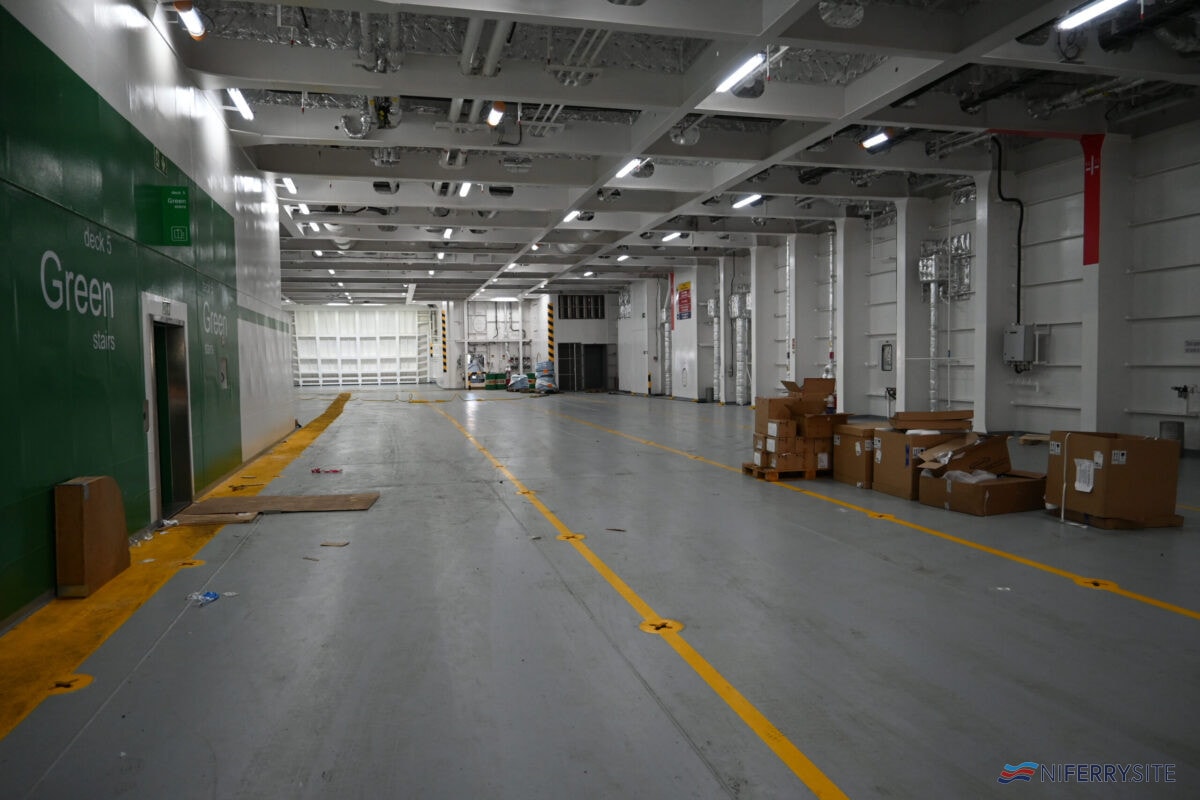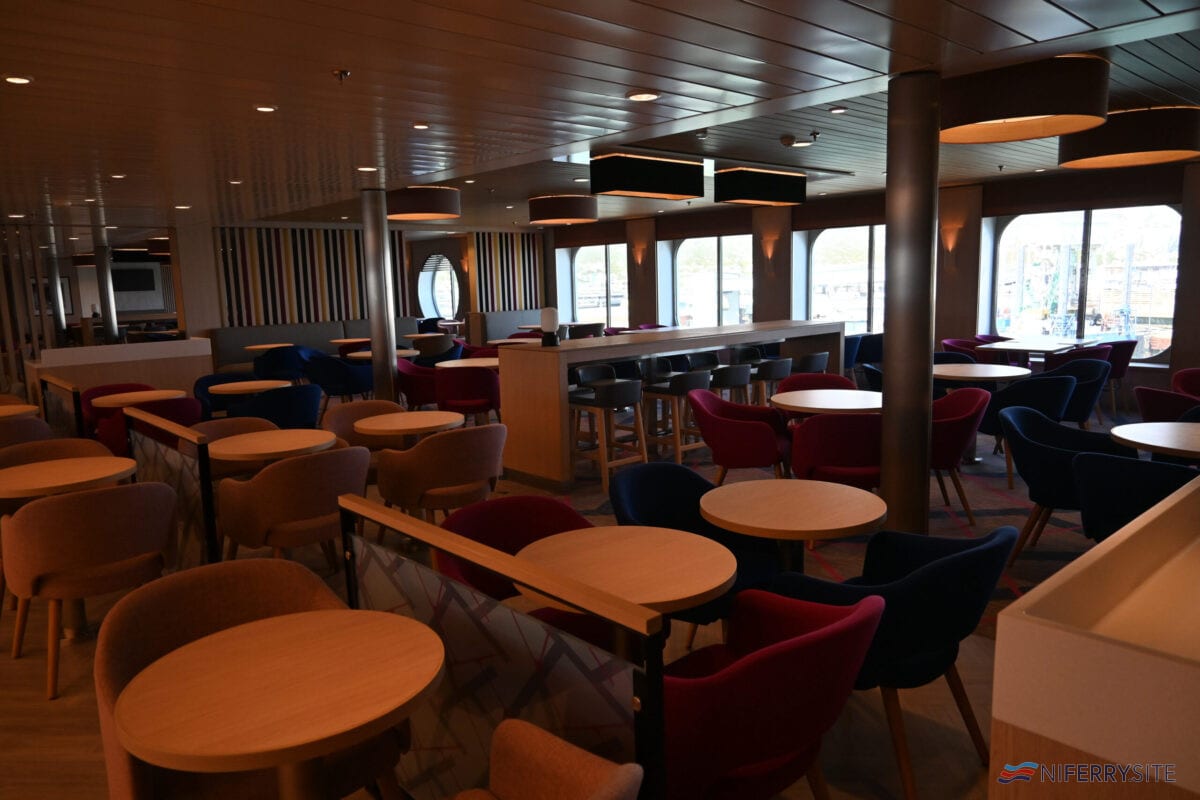Côte d'Opale Fast Facts
| Current Name: Côte d'Opale | Previous Names: |
| Shipyard: China Merchants Jinling Weihai [CN], #W0268, | IMO Number: 9858321 |
| Current Operator: DFDS | Current Route: Dover [GB] - Calais [FR] |
| Length Overall: 215.867m | Beam: 27.8 m |
| Passenger Capacity: 1,000 | Vehicle Capacity: 3,100 lane metres of freight and up to 120 passenger cars |
| Tonnage: 40,331 | Sister-ships: Côte d'Opale is a unique member of the Stena E-Flexer series of Ro-Pax ferries |
When Stena first introduced the E-Flexers, the focus was on their efficiency. With a class leading hull design, they would be able to carry more traffic on the same or less power than previous Ro-Paxes and to serve a variety of missions. But a second vital aspect of the E-Flexer concept was their ability to be used for a variety of different missions. And perhaps the clearest indication of this so far came with the ordering of a unit to be chartered to DFDS, for use on the intensive short sea routes from Dover. Requiring adaptations of both the passenger spaces, the access equipment and the machinery for manoeuvrability, the CÔTE D’OPALE is the epitome of flexibility and Stenability, and is the E-Flexer which differs most from the so far delivered units.

Access Arrangements
Keeping the same length overall as STENA ESTRID, CÔTE D’OPALE has bow and stern access modified for the Dover strait. This includes the ‘cow catcher’ at the bow which is a visual hallmark of all ships on the route. And at the stern she has doors which slide sideways. Internally there are further modifications of the vehicle decks with the upper car only deck having a wide bi-directional ramp offset to starboard, rather than the one adjacent to the funnel casing on the Edda and sisters. Whilst this upper car deck provides additional capacity, the loading arrangement requiring the use of hoistable ramps, will inevitably be slower to use than the fixed ramp upper deck access on the Dunkirk ships or the P&O Spirits. There is a small cellular vehicle hold on deck 1.

Public Areas
The public rooms are spread over decks 7 and 8. The aft end of deck 7 includes the partially open car only vehicle deck. DFDS have chosen to separate freight drivers from car passengers by giving each a separate deck of facilities.

The remainder of Deck 7 forwards is occupied by a very spacious Road Kings Freight Drivers Club. Within this space there is a substantial seating area and food servery. The entire area is fitted out to the standard of an upmarket business lounge with neutral colours and a variety of seating configurations. To port is an aft facing reclining seat lounge. At the aft end of that are 2 berths in small curtained off areas, these being a requirement of French regulations. The area also contains a toilet and shower block, and there is a small business centre with computers where drivers can check paperwork and route information for their onward journey. There is also a space for a small video game arcade, although the equipment had not been fitted at the time of the press event.

Deck 8 is for the car passengers. At the forward end is a vast Seven Seas restaurant, stretching the full width of the bow of the ship, with seating areas extending down the starboard side, this has a central food servery. Clearly designed to be able to serve as many passengers as possible during the 90 min crossing, the food service area feels noticeably bigger than the comparable space on the Stena ships. DFDS are making a big push on food quality onboard, whilst retaining the self-service model. From the introduction of CÔTE D’OPALE , the company will be making good use of the skills of the French chefs, and introducing classic dishes like Magret de Canard, and Tartiflette, alongside ferry staples such as Fish and Chips.

Moving aft from the Seven Seas buffet, there is a Lego playroom for kids, before passing the information desk and then entering the vast Duty Free shop. Occupying the space used for a bar on the Stena ships, and taking advantage of the skylight, this area is fully stocked and reminiscent of an upmarket airport shopping mall. With products ranging from the standard wines, spirits and perfume through to Lego and scented candles, this is, at 1100m2 by far the largest shop on a ship sailing from the UK. And the design ethos making the shop part of the onboard experience is similar to the idea on Tallink’s MEGASTAR and COLOR HYBRID. The tree sculptures are part of the visual effect, as are the lighting effects on the sides of the light well under the skylight. DFDS are going ‘all in’ on the shopping experience and will also open shore based shops in France for their customers.

Moving aft is another large public space, the Lighthouse Cafe. Combining swathes of seating and a bright coffee shop ambience, with an adjacent Pirates Island kids play area, this will be the main passenger space for those not wanting a full meal.

On the starboard side is the Premium Lounge. Again in neutral tones, and with included snacks and drinks, this lounge also has direct access to the outer decks at the stern. In general it is considerably easier to find than the comparable space on the other Calais ships. Surprisingly the Premium Lounge does not have its own dedicated toilet facilities.

At the aft end of Deck 8 is an open deck area which wraps around the funnel. At the time of writing this is a space without any furniture, and with it being so sheltered from the wind, it would make a great location for a drink on a sunny day as one sets sail.

Other Spaces
Deck 9 is crew accommodation, including crew cabins and the bridge forward.

Deck 10, is the roof of the accommodation and the base of the funnel. The railings indicate that this area may at times be open with gates to close it off at the forward end. However given that this deck is essentially the roof of the crew cabins, I would not expect too much footfall to be encouraged up here. When standing on Deck 10 the offset funnel is quite noticeable.
Final Thoughts
One of the nicer visual effects on the Stena E-Flexers was the ability to walk straight from a vehicle parked on the upper most vehicle deck into the reception and atrium. The layout of the public spaces on the Cote D’Opale means that all car passengers will need to climb at least 1 deck to find their public spaces. But once they do, the size of the space relative to the passenger capacity mean that the ship should never feel crowded. The décor is overall more muted than the Stena series, but nonetheless still attractive and fresh, providing a pleasant way to cross the channel and a significant improvement from the Calais Seaways which she has replaced.

CÔTE D’OPALE will carry 1,000 passengers and up to 3,100 lane metres of vehicles. Her service speed will typically be 20-22kts although she did reach 24kts on her delivery voyage. She was named in Calais earlier today, 4 August, by Peggy Bouchet – a French rower and the first woman to row across the Atlantic.
CÔTE D’OPALE is chartered by DFDS from Stena Roro for an initial period of 10 years. Further images taken onboard the new ferry can be found at our “First Look” feature here.

